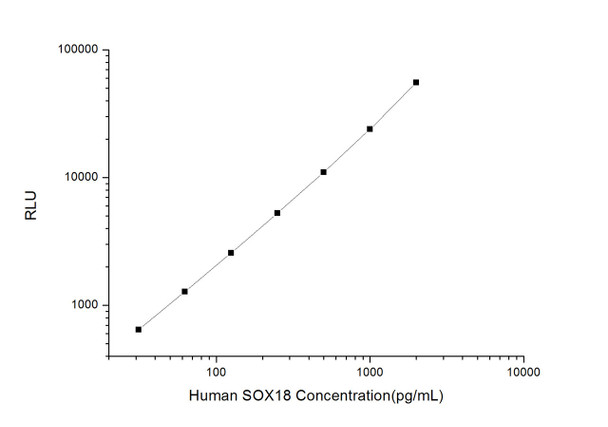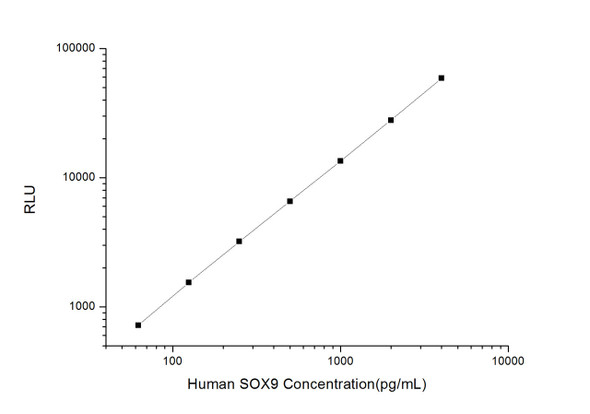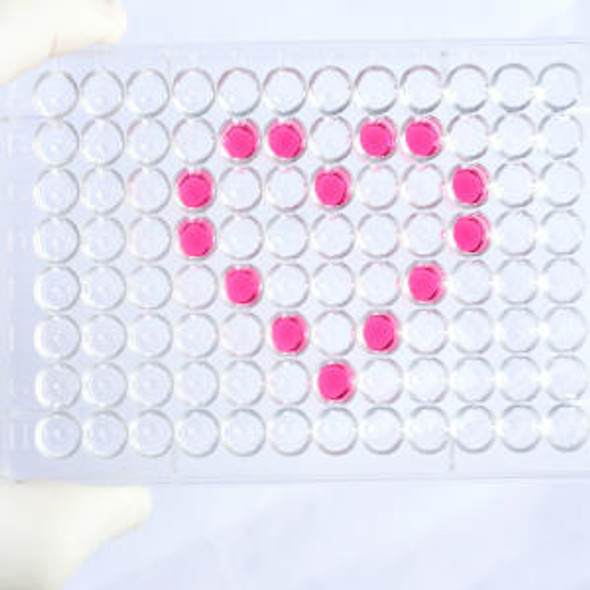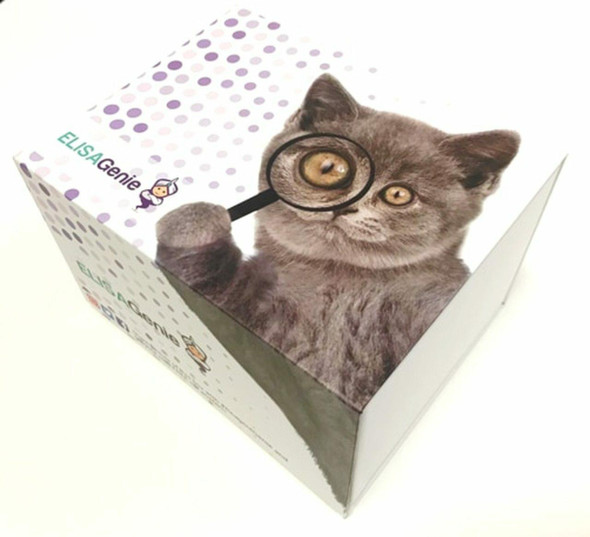Human Epigenetics and Nuclear Signaling ELISA Kits
Human SOX18 (Sex Determining Region Y Box Protein 18) CLIA Kit (HUES01133)
- SKU:
- HUES01133
- Product Type:
- ELISA Kit
- ELISA Type:
- CLIA Kit
- Size:
- 96 Assays
- Sensitivity:
- 18.75pg/mL
- Range:
- 31.25-2000pg/mL
- ELISA Type:
- Sandwich
- Reactivity:
- Human
- Sample Type:
- Serum, plasma and other biological fluids
- Research Area:
- Epigenetics and Nuclear Signaling
Description
| Assay type: | Sandwich |
| Format: | 96T |
| Assay time: | 4.5h |
| Reactivity: | Human |
| Detection method: | Chemiluminescence |
| Detection range: | 31.25-2000 pg/mL |
| Sensitivity: | 18.75 pg/mL |
| Sample volume: | 100µL |
| Sample type: | Serum, plasma and other biological fluids |
| Repeatability: | CV < 15% |
| Specificity: | This kit recognizes Human SOX18 in samples. No significant cross-reactivity or interference between Human SOX18 and analogues was observed. |
This kit uses Sandwich-CLIA as the method. The micro CLIA plate provided in this kit has been pre-coated with an antibody specific to Human SOX18. Standards or samples are added to the appropriate micro CLIA plate wells and combined with the specific antibody. Then a biotinylated detection antibody specific for Human SOX18 and Avidin-Horseradish Peroxidase (HRP) conjugate are added to each micro plate well successively and incubated. Free components are washed away. The substrate solution is added to each well. Only those wells that contain Human SOX18, biotinylated detection antibody and Avidin-HRP conjugate will appear fluorescence. The Relative light unit (RLU) value is measured spectrophotometrically by the Chemiluminescence immunoassay analyzer. The RLU value is positively associated with the concentration of Human SOX18. The concentration of Human SOX18 in the samples can be calculated by comparing the RLU of the samples to the standard curve.
| UniProt Protein Function: | SOX18: Binds to the consensus sequence 5'-AACAAAG-3' and is able to trans-activate transcription via this site. Defects in SOX18 are the cause of hypotrichosis- lymphedema-telangiectasia syndrome (HLTS). |
| UniProt Protein Details: | Protein type:DNA-binding; Transcription factor Chromosomal Location of Human Ortholog: 20q13. 33 Cellular Component: nuclear chromatin; nucleus Biological Process: angiogenesis; blood vessel endothelial cell migration; embryonic heart tube development; hair cycle process; heart looping; lymphangiogenesis; mRNA transcription from RNA polymerase II promoter; negative regulation of transcription from RNA polymerase II promoter; negative regulation of transcription, DNA-dependent; positive regulation of transcription from RNA polymerase II promoter; positive regulation of transcription, DNA-dependent; vasculature development; vasculogenesis Disease: Hypotrichosis-lymphedema-telangiectasia Syndrome; Hypotrichosis-lymphedema-telangiectasia-renal Defect Syndrome |
| NCBI Summary: | This gene encodes a member of the SOX (SRY-related HMG-box) family of transcription factors involved in the regulation of embryonic development and in the determination of the cell fate. The encoded protein may act as a transcriptional regulator after forming a protein complex with other proteins. This protein plays a role in hair, blood vessel, and lymphatic vessel development. Mutations in this gene have been associated with recessive and dominant forms of hypotrichosis-lymphedema-telangiectasia. [provided by RefSeq, Jul 2008] |
| UniProt Code: | P35713 |
| NCBI GenInfo Identifier: | 12644232 |
| NCBI Gene ID: | 54345 |
| NCBI Accession: | P35713. 2 |
| UniProt Secondary Accession: | P35713,Q0VGA9, Q9NPH8, |
| UniProt Related Accession: | P35713 |
| Molecular Weight: | 40,891 Da |
| NCBI Full Name: | Transcription factor SOX-18 |
| NCBI Synonym Full Names: | SRY-box 18 |
| NCBI Official Symbol: | SOX18 |
| NCBI Official Synonym Symbols: | HLTS; HLTRS |
| NCBI Protein Information: | transcription factor SOX-18 |
| UniProt Protein Name: | Transcription factor SOX-18 |
| Protein Family: | Transcription factor |
| UniProt Gene Name: | SOX18 |
| UniProt Entry Name: | SOX18_HUMAN |
As the RLU values of the standard curve may vary according to the conditions of the actual assay performance (e. g. operator, pipetting technique, washing technique or temperature effects), the operator should establish a standard curve for each test. Typical standard curve and data is provided below for reference only.
| Concentration (pg/mL) | RLU | Average | Corrected |
| 2000 | 51694 59748 | 55721 | 55693 |
| 1000 | 22942 25006 | 23974 | 23946 |
| 500 | 11565 10499 | 11032 | 11004 |
| 250 | 5222 5366 | 5294 | 5266 |
| 125 | 2653 2563 | 2608 | 2580 |
| 62.5 | 1338 1284 | 1311 | 1283 |
| 31.25 | 643 705 | 674 | 646 |
| 0 | 28 28 | 28 | -- |
Precision
Intra-assay Precision (Precision within an assay): 3 samples with low, mid range and high level Human SOX18 were tested 20 times on one plate, respectively.
Inter-assay Precision (Precision between assays): 3 samples with low, mid range and high level Human SOX18 were tested on 3 different plates, 20 replicates in each plate.
| Intra-assay Precision | Inter-assay Precision | |||||
| Sample | 1 | 2 | 3 | 1 | 2 | 3 |
| n | 20 | 20 | 20 | 20 | 20 | 20 |
| Mean (pg/mL) | 102.41 | 174.44 | 900.43 | 98.92 | 160.50 | 959.78 |
| Standard deviation | 9.43 | 13.01 | 88.96 | 9.08 | 13.53 | 108.94 |
| C V (%) | 9.21 | 7.46 | 9.88 | 9.18 | 8.43 | 11.35 |
Recovery
The recovery of Human SOX18 spiked at three different levels in samples throughout the range of the assay was evaluated in various matrices.
| Sample Type | Range (%) | Average Recovery (%) |
| Serum (n=5) | 89-100 | 94 |
| EDTA plasma (n=5) | 90-105 | 97 |
| Cell culture media (n=5) | 92-105 | 99 |
Linearity
Samples were spiked with high concentrations of Human SOX18 and diluted with Reference Standard & Sample Diluent to produce samples with values within the range of the assay.
| Serum (n=5) | EDTA plasma (n=5) | Cell culture media (n=5) | ||
| 1:2 | Range (%) | 96-113 | 99-114 | 98-111 |
| Average (%) | 104 | 105 | 105 | |
| 1:4 | Range (%) | 100-114 | 100-119 | 89-104 |
| Average (%) | 107 | 108 | 96 | |
| 1:8 | Range (%) | 89-100 | 85-100 | 98-112 |
| Average (%) | 95 | 91 | 106 | |
| 1:16 | Range (%) | 103-119 | 97-110 | 86-98 |
| Average (%) | 109 | 103 | 91 |
An unopened kit can be stored at 4°C for 1 month. If the kit is not used within 1 month, store the items separately according to the following conditions once the kit is received.
| Item | Specifications | Storage |
| Micro CLIA Plate(Dismountable) | 8 wells ×12 strips | -20°C, 6 months |
| Reference Standard | 2 vials | |
| Concentrated Biotinylated Detection Ab (100×) | 1 vial, 120 µL | |
| Concentrated HRP Conjugate (100×) | 1 vial, 120 µL | -20°C(shading light), 6 months |
| Reference Standard & Sample Diluent | 1 vial, 20 mL | 4°C, 6 months |
| Biotinylated Detection Ab Diluent | 1 vial, 14 mL | |
| HRP Conjugate Diluent | 1 vial, 14 mL | |
| Concentrated Wash Buffer (25×) | 1 vial, 30 mL | |
| Substrate Reagent A | 1 vial, 5 mL | 4°C (shading light) |
| Substrate Reagent B | 1 vial, 5 mL | 4°C (shading light) |
| Plate Sealer | 5 pieces | |
| Product Description | 1 copy | |
| Certificate of Analysis | 1 copy |
- Set standard, test sample and control (zero) wells on the pre-coated plate and record theirpositions. It is recommended to measure each standard and sample in duplicate. Note: addall solutions to the bottom of the plate wells while avoiding contact with the well walls. Ensuresolutions do not foam when adding to the wells.
- Aliquot 100 µL of standard solutions into the standard wells.
- Add 100 µL of Sample / Standard dilution buffer into the control (zero) well.
- Add 100 µL of properly diluted sample (serum, plasma, tissue homogenates and otherbiological fluids. ) into test sample wells.
- Cover the plate with the sealer provided in the kit and incubate for 90 min at 37 °C.
- Aspirate the liquid from each well, do not wash. Immediately add 100 µL of BiotinylatedDetection Ab working solution to each well. Cover the plate with a plate seal and gently mix. Incubate for 1 hour at 37 °C.
- Aspirate or decant the solution from the plate and add 350 µL of wash buffer to each welland incubate for 1-2 minutes at room temperature. Aspirate the solution from each well andclap the plate on absorbent filter paper to dry. Repeat this process 3 times. Note: a microplatewasher can be used in this step and other wash steps.
- Add 100 µL of HRP Conjugate working solution to each well. Cover with a plate seal andincubate for 30 min at 37 °C.
- Aspirate or decant the solution from each well. Repeat the wash process for five times asconducted in step 7.
- Add 100 µL of Substrate mixture solution to each well. Cover with a new plate seal andincubate for no more than 5 min at 37 °C. Protect the plate from light.
- Determine the RLU value of each well immediately.






